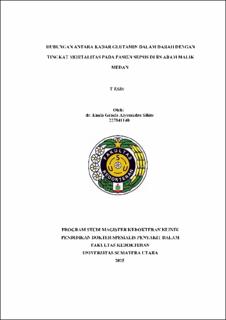Hubungan Antara Kadar Glutamin dalam Darah dengan Tingkat Mortalitas pada Pasien Sepsis di RS Adam Malik Medan
The Relationship between Serum Glutamine Levels and Mortality in Sepsis Patients at Adam Malik General Hospital Medan

Date
2025Author
Sihite, Enola Gracia Alyssandra
Advisor(s)
Ginting, Franciscus
Sihotang, Lenni
Metadata
Show full item recordAbstract
Sepsis remains a leading cause of morbidity and mortality in critically ill patients.
Glutamine, a conditionally essential amino acid, plays an important role in immune
function, intestinal integrity, and inflammatory response. This study aimed to
analyze the association between serum glutamine levels and mortality in sepsis
patients. A cross-sectional study with a retrospective design was conducted on 36
sepsis patients admitted to H. Adam Malik General Hospital Medan between April
and June 2025. Data were collected from medical records, including demographic
characteristics, antibiotic therapy, body mass index (BMI), Charlson Comorbidity
Index (CCI), and serum glutamine levels. Statistical analysis was performed using
bivariate tests, logistic regression, and ROC curve analysis. The results showed
that the mean serum glutamine level was 3.8 ng/mL, with an optimal cut-off value
of 3.9 ng/mL (AUC 0.72; p<0.05). Patients with serum glutamine levels <3.9 ng/mL
had a significantly higher risk of mortality compared to those with levels ≥3.9
ng/mL (OR 5.2; 95% CI: 1.1–24.6; p<0.05). Most patients had normal BMI and
low-to-moderate CCI scores, with the respiratory tract being the most common
source of infection. In conclusion, lower serum glutamine levels are significantly
associated with increased mortality in sepsis patients. This finding highlights the
potential role of serum glutamine measurement as a simple prognostic biomarker
in the clinical evaluation of sepsis, as well as its relevance in guiding preventive
and nutritional management strategies.
